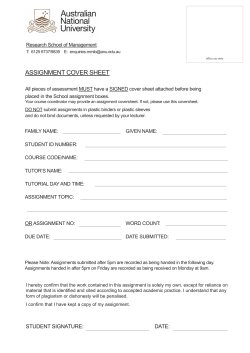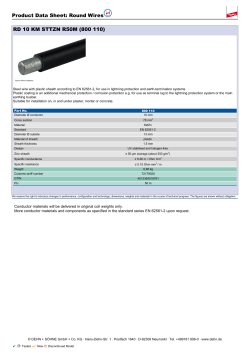
ROOTING OF MANGO AIR-LAYERS PREPARED DURING WINTER
ROOTING OF MANGO AIR-LAYERS PREPARED DURING WINTER IN RELATION TO THE USE OF BLACK AS OPPOSED TO CLEAR PLASTIC Abstract Merensky Technological Services, PO Box 14, Duivelskloof 0835 Mango air-layerswere preparedduring winter using black and clear polyethylene plastic to ascertainwhetherblackplastic would effect a higherincidenceof rooting.Thirty-threepercent of the air-layerspreparedwith blackplastic and7% of those preparedwith clearplastic rooted. This result indicated a benefit to using black as opposedto clear plastic in preparingmango air-layers in winter. INTRODUCTION Vegetative propagation of the important mango cultivars grown locally will enable growing them on their own roots. Such trees may exhibit a lesser degree of vigour and a greater degree of precocity than trees grown by grafting on the polyembryonic varieties currently used as rootstocks; low vigour and precocity being desirable attributes for the modern orchardist. On May 17,1990,30 air-layers were prepared within a 14-year-old, commercial Sensation orchard in the Letsitele Valley (north-eastern Transvaal; grower: M. Amm); 15 air-layers using clear polyethylene plastic, and 15 air-layers using black polyethylene plastic. A completely randomised design was employed. Single shoots served as plots. Shoots at waist height on the west side of a number of adjacent trees were chosen (row orientation: north-south). Girdles, 40 mm-wide, were made just above the base the subterminal flush with a budding knife. In girdling, care was taken to remove all traces of tissue surrounding the secondary xylem. IBA, at a concentration 25000 ppm in hydrous lanolin, was smeared over the exposed xylem to completely cover it. The A technique of air-layering employed by Schroeder (pers comm, CSFRI, Nelspruit) involved applying indole butyric acid (IBA) at a concentration of 25000 ppm in hydrous lanolin to a 400 mmwide girdle made some distance from the growing point. Following application, Irish peat-moss mixed with compost (1:1) was moistened to the point that a sample squeezed tightly by hand yielded a few drops of water. A handful of this medium was applied to the girdle, and then secured to it by tightly wrapping clear polyvinyl chloride (PVC) plastic around the medium. String ties were made at either end of the girdle and over the plastic to keep the plastic wrapping in place. According to Schroeder, rooting occurs five to six months after preparing the airlayers. It was indicated that the time of preparation in relation to season influences the time taken for rooting to occur and the percentage of air-layers that develop roots, and better results can be expected when air-layers are prepared during spring and summer as opposed to during autumn and winter. The differential response with regard to season may be related to the temperature of the medium during the months prior to rooting. In adopting a method of air-layering differing somewhat from that used by Schroeder, it was aimed, in the present study, to determine whether using black as opposed to clear . plastic, would enhance the rooting percentage of mango air-layers prepared in winter. Fig 1 Appearanceof the air-layersafter their preparation. pared with black plastic developed roots (p for ditto < 0,05). This result indicates a benefit to using black as opposed to clear plastic when preparing mango airlayers during winter. Figure 2 shows a number of the airlayers after removing the plastic and medium. Callusing at the edges of the girdle always occurred. This might be seen to indicate that the air-layers failing to root may still have rooted had they been left on the trees for longer. In one instance, callus tissue had completely bridged the girdle. This was probably due to incomplete removal of the cambium at the time of girdling. Schroeder advised that after rooted airlayers are potted, they be placed in a mist-bed until the root system is well developed. He found that rooted air-layers not placed under mist often died back due to the inability of the roots to absorb sufficient water. Fig 2 Appearance of a number of air-layers after the plastic and medium were removed. Left to right: 1) bridging of the girdle by callus tissue; 2) an air-layer showing little callus growth at the edges of the girdle; 3) a well rooted air-layer; 4) an air-layer having only developed a single primary root. girdles were then enclosed in 300 mmlong and 110 mm-wide polyethylene sleeves by inserting the shoots through the sleeves. A tight string-tie was made over the plastic and beneath the base of the girdle to secure the sleeve to the shoot. Moistened Canadian peat-moss (3 e H20:20 e peat) was then inserted and compacted within the sleeve until the girdle was entirely covered. To complete the air-layer, a string-tie was tightly made over the plastic and above the site of the girdle in such a way as to keep the medium firmly in place around the girdle. Figure 1 shows the appearance of the completed air-layers. On October 29, five months and 12 days after preparing the air-layers, they were removed from the trees by pruning and inspected for rooting. The experiment was then terminated. Many other aspects could be considered in endeavouring to improve the rooting percentage of mango air-layers. These include the incorporation of fungicides and nutrients in the medium, using black plastic that is semi-permeable to gases (PVC plastic), and girdling younger wood. Schroeder reported a 67% success rate in rooting. A success rate of over 80% would be desired regardless of the time of year air-layers are prepared, indicating a need for continued research on air-layering as a method of vegetatively propagating mango. ACKNOWLEDGEMENTS Seven percent of the air-layers prepared with clear plastic, and 33% of those pre- Thanks are due to Mike Amm for mak· ing trees available for this study. SUPPLIERS OF EXPORT FRUIT AND VEGETABLES P.O. BOX 106 EPPINDUST 7475 CAPE TOWN R.S.A. For professional and personal service contact: Roy Fine or Celia Nel TEL. (021) 531-6441 TELEX 5-26445 FAX (021) 531-3719
© Copyright 2025









